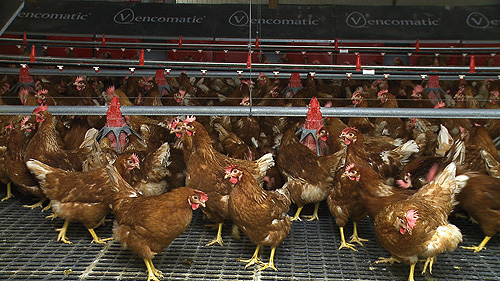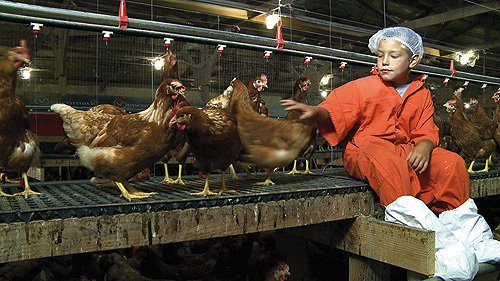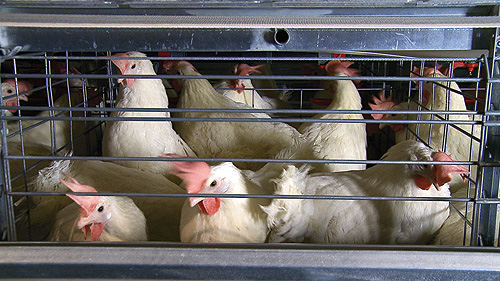 Harry & David wasn’t planning to move to cage-free eggs in the company’s bakery products, but the idea certainly fit the corporate strategy “to make the most natural, wholesome product possible,” according to VP Pete Kratz.
Harry & David wasn’t planning to move to cage-free eggs in the company’s bakery products, but the idea certainly fit the corporate strategy “to make the most natural, wholesome product possible,” according to VP Pete Kratz.
 |
 |
Willamette Egg Farms has 3% of their hens in a cage-free environment. |
 |
Hens in a modern conventional cage which is just under 4 square feet and holds eight hens. // Photos courtesy of Willamette Egg Farms. |
Harry & David wasn’t planning to move to cage-free eggs in the company’s bakery products, but the idea certainly fit the corporate strategy “to make the most natural, wholesome product possible,” according to VP Pete Kratz.
So when the Humane Society of the United States came calling as part of their nationwide effort to eliminate the practice of confining egg-laying hens in small “battery” cages, the decision was simple.
Harry & David became the first major Oregon-based company to decide to exclusively use cage-free eggs, according to the Humane Society.
“There was no consumer pressure,” says Kratz. “It sort of fit right in to what we were looking at. We’ve reformulated over 82 products this fall to eliminate transfats.” Most of the products in Harry & David’s signature upscale fruit baskets and other high-end foods don’t have eggs in them, but the switch still will cost between $30,000 and $50,000 annually, about 25% to 30% more expensive than caged eggs. The company uses about 150,000 eggs per year.
The timing was good news for Willamette Egg Farms in Canby, which supplies Harry & David with its eggs. “We were already in the process of increasing our cage-free productions,” says VP Greg Satrum. The switch “was great for us because we need the sales for those eggs.”
Willamette Egg is the largest egg producer in the state. Its 1.2 million Oregon hens produce 1 million eggs a day. Satrum says about 3% of the birds will be cage-free in the next few months. Market demand didn’t drive the decision, but market projection did. After seeing growth in 2006-2007, “demand has not been strong for cage-free over the last few years with the economy,” he says.
Nationally, prices can swing from as low as 80 cents for a dozen conventional eggs to more than $4 a dozen for organic free-range eggs.
Cage-free eggs are more expensive than conventional eggs because it requires more feed, labor, medication and space to care for the hens. Cage-free doesn’t mean the hens roam free outside; only “free-range” designates that. Satrum says a modern conventional cage today is just under 4 square feet and holds eight hens and that the trend has been toward larger cages for many years. The cage that was widely used in the 1960s and 1970s, and still in use today, measures 12 inches by 20 inches.
Nationally, the demand for non-cage eggs has remained constant for the past four to five years, about 5% of U.S. consumption, according to Mitch Head, spokesman for the United Egg Producers. “We don’t see a dramatic increase in demand on the non-cage eggs,” he says, “95% [of consumers] are still voting with their wallets for caged eggs. Eggs that come from modern, clean cages are humane. Cage- free provides some benefits that modern cages don’t, and vice versa.”
Though it was an easy decision for a company like Harry & David, caged hens is a controversial debate. In the past several years, businesses such as Burger King, Starbucks and Denny’s have switched to cage-free eggs. In Oregon, seven private colleges have gone to cage-free eggs, along with two culinary schools and the corporate cafeterias at Nike and Adidas. Myriad restaurants and cafes around the state also exclusively use cage-free eggs. Burgerville, based in Vancouver, Wash., went cage-free several years ago. Whole Foods sells only cage-free eggs, and most all U.S. supermarkets now carry cage-free eggs, according to the Humane Society.
But McDonald’s earlier this year said the science was not there to support a change. In response to similar questions from the egg industry, the Coalition for Sustainable Egg Supply is doing a study led by Michigan State University and the University of California, Davis, to evaluate the various housing systems. Europe will ban the use of conventional cages in 2012.
The Humane Society is clear about its intent: extreme confinement is inhumane and they and other animal welfare groups want battery cages banned. The Humane Society has had some success in helping change how the nation’s 290 million egg-laying hens are kept. In California, extreme confinement will be banned by 2015; in Michigan, a hen must have at least one square foot of floor space beginning in 2019; and in Ohio farmers have agreed to bar new egg farms using battery cages.
“We are discussing whether to pursue battery cage legislation in Oregon,” says Kelly Peterson with the Oregon Humane Society. “I think voters and lawmakers would be amenable.”
Will consumers pay more for those eggs? “There’s the magic question,” says Satrum. “I don’t see production in the U.S. going away from cages any time soon.”


